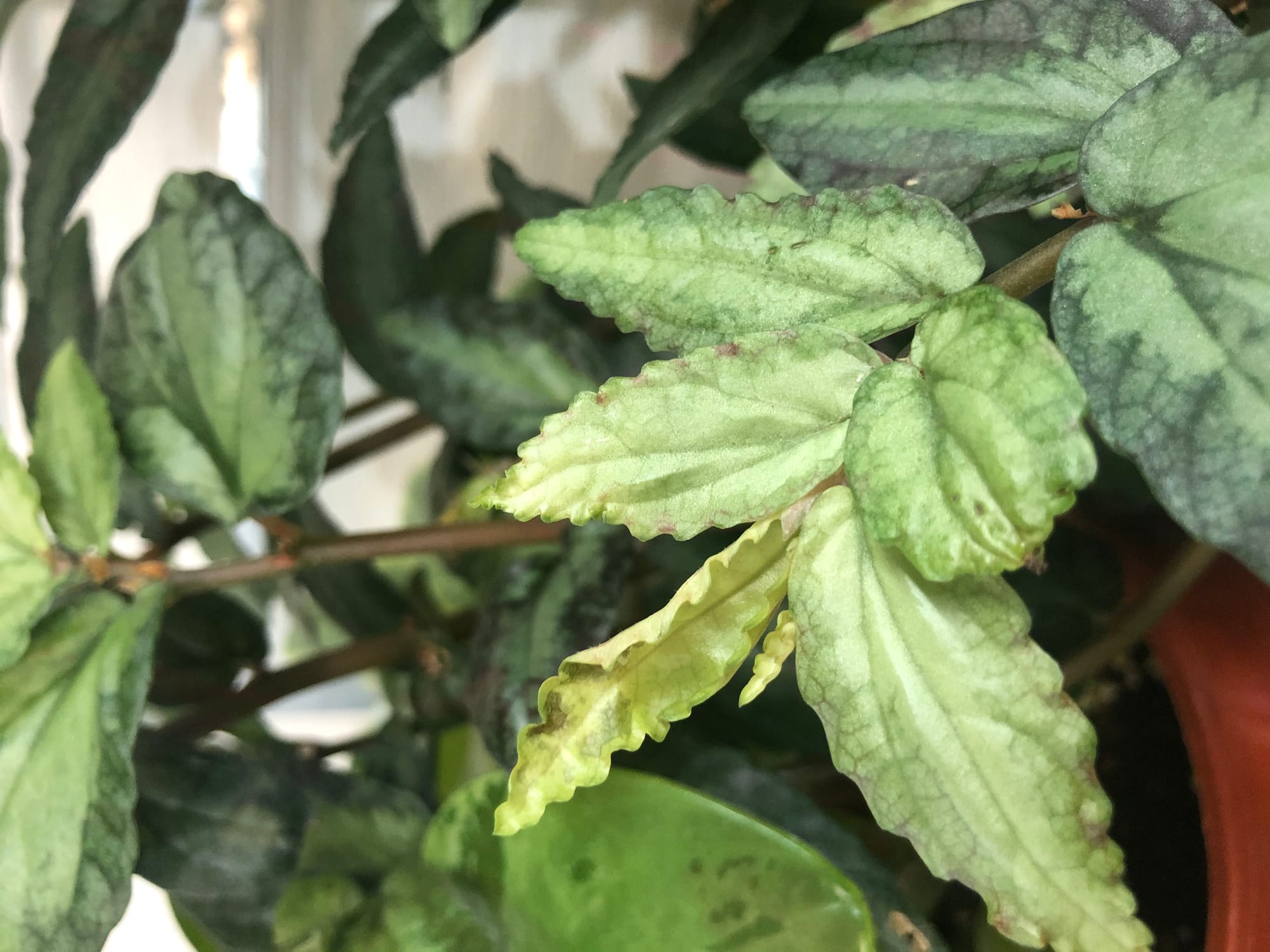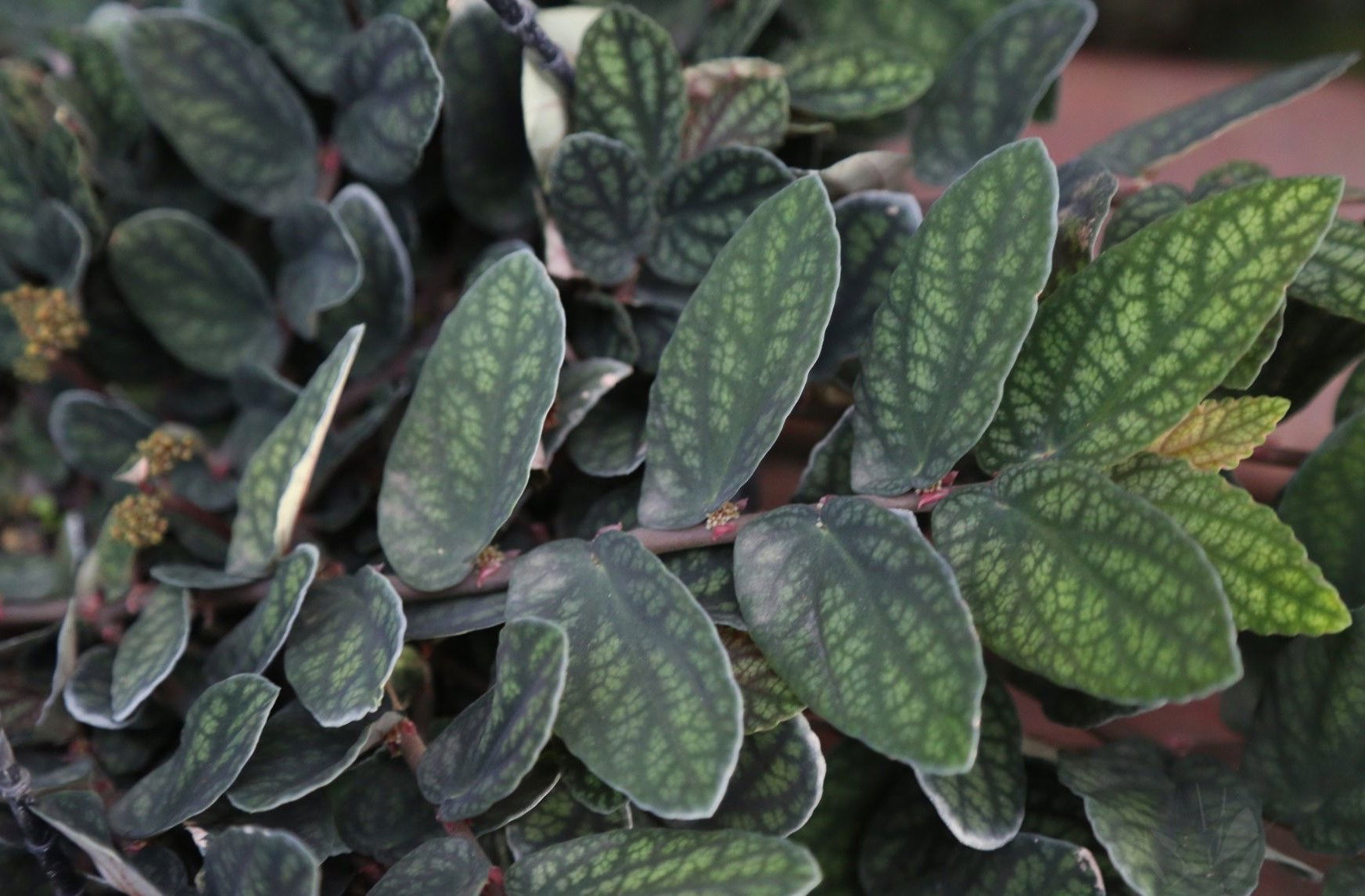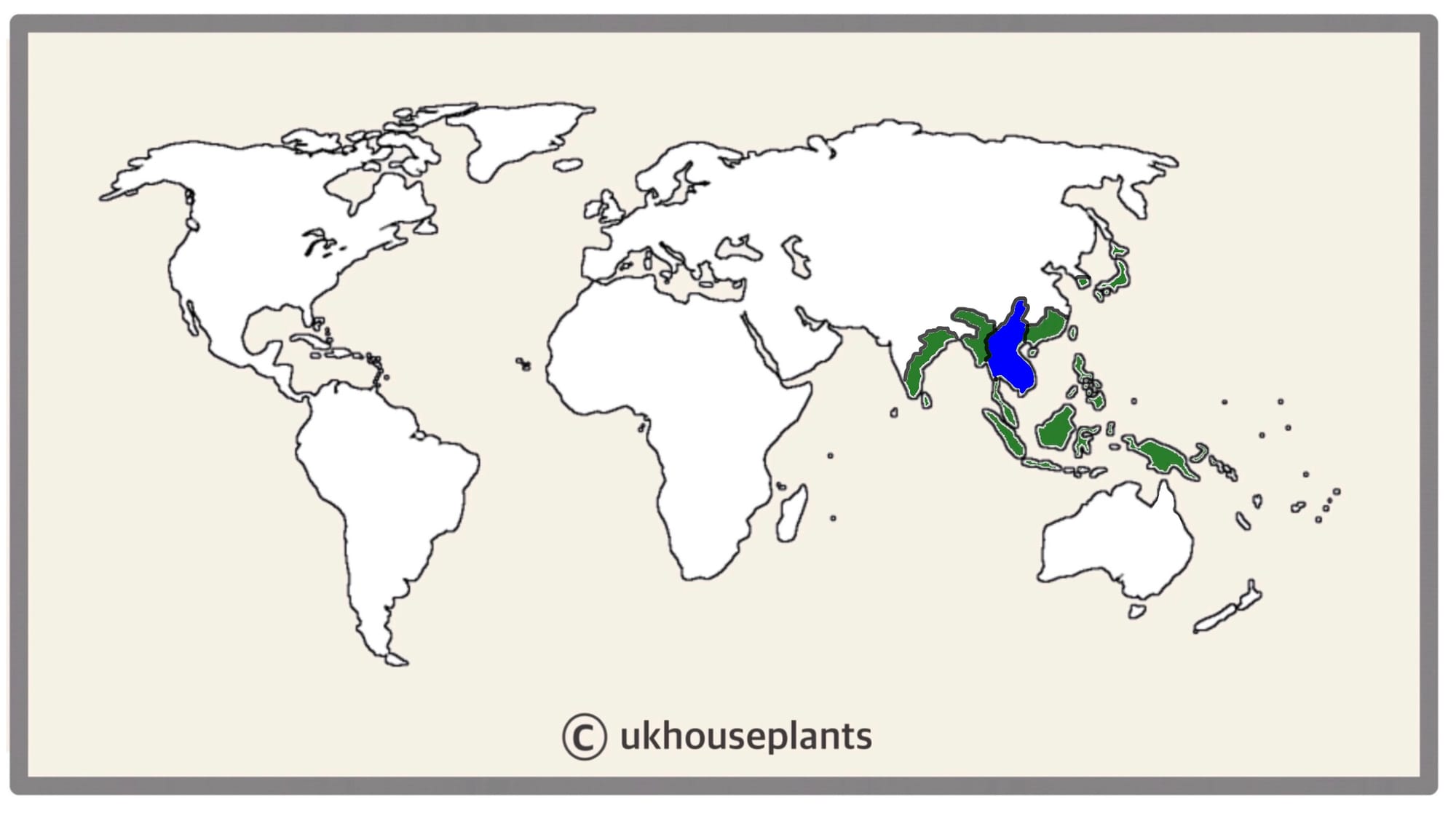
Procris repens - Formally known as 'Pellionia repens'.
Contents
- Top Tips
- Location, Water, Humidity & Fertilisation
- Common Issues
- Origins, Temperature, Propagation, Repotting & Toxicity.
Need the answer to a specific plant query? Book a 1-to-1 video call with THE HOUSEPLANT DOCTOR™, the website's friendly author, to overcome and address your niggling problem! Available on iMessage, WhatsApp, Facebook Messenger & more.
Top Tips & Info
- Care Difficulty - Easy
- We'd recommend situating yours in bright, indirect light away from issues of low temperatures or excessive sunlight.
- Keep the soil evenly moist, allowing the pot to become light when lifted before administering more water. You can even feel the top two inches of the compost for confirmation that the specimen needs hydration.
- Fertilise using a 'Houseplant' labelled feed every four waters in the spring and summer, reducing this to every six in the colder months.
- In spring, repot every three years with a 'Houseplant' labelled compost. Water the plant 24hrs beforehand, to reduce the risk of damaging the root hairs, otherwise known as 'Transplant Shock'.
- Keep an eye out for mealybugs that may arise within the cubbyholes of its foliage. Click here to learn more about this issue.
- To save confusion within this article, we'll be referring to Procris repens (describes Pellionia repens AND P. pulchra in taxonomy) as 'Pellionia' - its original and most still popular name.
Location & Light - 🔸🔸🔸
Provide a bright, indirect location that offers a reliable level of humidity, air circulation and temperature. A position that offers more than an hour of direct light must be kept off the cards, due to their susceptibility to sun-scorch. A site within two metres of a north, east or west-facing window, or below a skylight window is the ideal area.
Water - 🔸🔸
Moist soil is mandatory for a happy specimen. Allow the soil's top third to dry out in between irrigations, reducing this slightly further in the autumn and winter. Do not, under any circumstances, promote periods of droughts due to the species' reduced ability to endure dehydration. Under-watering symptoms include the curling or crisping of leaves, yellowed foliage, stunted growth and a 'washed out' appearance. These issues are usually caused by too little soil moisture and too much light/heat. Over-watering will create leaf-loss at the base (leaves closest to the soil), root rot, and possible stem collapse. These are usually down to too much soil moisture - be sure to allow at least a third of the soil dry out in between waterings and consider a brighter location, too. Scroll down to 'Common Issues' for more information on this.
Humidity - 🔸
Create a humidity tray to provide a moist and stable environment for your plant. If the surrounding saturation is too low or the heat too high, its leaf-tips may start to brown over and curl, especially in direct sunlight. Gently hose the foliage down from time to time to hydrate the leaves and keep the dust levels down. Pellionia can, however, grow in average room humidity rather well, so don't overshoot the mark with oner-humidification as it may result in eventual rotten foliage.
Fertilisation - 🔸
Fertilise every four waters during the growing period before reducing this to every six in the autumn & winter. Although an 'All-Purpose' fertiliser will still do the job, we'd recommend using a specific 'Houseplant' labelled fertiliser as it'll support the vital thirteen nutrients that this species will need to grow.
 Procris repens - formally known as Pellionia pulchra. Copyright: Oxley Nursery
Procris repens - formally known as Pellionia pulchra. Copyright: Oxley Nursery
Common Issues with Pellionia
Root rot is the biggest issue. Typical symptoms include rapidly yellowing leaves, stunted growth and stem collapse. Those situated in darker locations and/or too-soggy soil are most likely to be hit with this issue. Take the plant out of the pot and inspect its root systems - if they sport a yellow appearance, you're okay, but if they're brown and mushy, action must be taken immediately. More information about addressing root rot can be found on this link.
A lack of leaves on the soil’s top could be the product of excess moisture settling on the foliage. Although watering from the top is best, it's recommended to use the bottom-up method if you're a messy waterer. For specimens that have a bare head, improve growing conditions by using this method and increasing the light levels and air circulation. Take vine cuttings to promote a bushier appearance above the soil line - scroll down to 'Propagation for more information. Finally, always remove yellowed or rotten debris from the soil as it could harbour both bacterial and fungal diseases which will continue the plant's decline.
Never situate it within three metres of an operating heat source, for instance a radiator or fireplace. Due to the heightened temperature, the plant will soak up far more moisture than those situated in cooler locations, increasing the chance of droughts and browning leaf-edges.
Too much sunlight will lead to sun scorch, with typical signs including the browning or crisping of leaves, dry leaf-edges, sunken leaves or stunted growth. Although too little light will cause over-watering issues, too much sunlight will be a detriment, too. If yours has fallen short of this, reduce the amount of sunlight considerably and always be mindful of environmental shock (when too locations offer too different growing conditions). Remove some of the affected leaves and increase waters slightly.
As mentioned before, Powdery Mildew and Southern Blight are major threats among heavy foliage plants when excess moisture is allowed to sit on compacted foliage. Remove the affected areas and improve the growing conditions by situating the plant in a brighter location and keeping the leaves dry.
Mould or mushrooms developing on the soil means two things - too little light and over-watering. Despite the harmlessness, it'll prove unsightly to most gardeners and is therefore removed once known. To remove, replace the top two inches of the soil for a fresh batch of 'Houseplant' compost. Either increase the amount of light received (no direct sunlight for the first few weeks to prevent environmental shock) or decrease the frequency of waters slightly. If the mould is accompanied by yellowing lower leaves, you may also have a case of root rot.
 Vine cuttings are easy, reliable and quick to root. Scroll down to 'Propagation' for more information on how to perform the perfect cutting!
Vine cuttings are easy, reliable and quick to root. Scroll down to 'Propagation' for more information on how to perform the perfect cutting!
Origins
João de Loureiro first described the species in 1790 as 'Polychroa repens', describing its multi-coloured foliage and creeping nature. The taxonomy shifted several times during the 19th and 20th century, hopping from Elatostema to Pellionia, until its final resting name of 'Procris repens' by Barry Conn & Julisasi Hadiah, in the late 20th century. The popular and original term, Pellionia repens, was first penned by Elmer Drew Merrill in 1928, placing the species in the genus of Pellionia that honoured French explorer, Alphonse Pellion.

Temperature
12° - 30°C (54° - 86°F)
H1b (Hardiness Zone 12) - Can be grown outdoors during the summer in a sheltered location with temperatures above 12℃ (54℉), but is fine to remain indoors, too. If you decide to bring this plant outdoors, don't allow it to endure any direct sunlight as it may result in sun-scorch and dehydration. Regularly keep an eye out for pests, especially when re-introducing it back indoors.
Spread
Up to 1.4m in vine length, with the ultimate height being reached in 3 - 5 years.
Pruning
Remove yellow or dying leaves, and plant debris to encourage better-growing conditions. While pruning, always use clean utensils or shears to reduce the chance of bacterial and fungal diseases. Never cut through yellowed tissue as this may cause further damage in the likes of diseases or bacterial infections. Remember to make clean incisions as too-damaged wounds may shock the plant, causing weakened growth and a decline in health.
Propagation
Via Seed or Vine Cuttings.
Vine Cuttings
- Choose the healthiest, most established vines from the leading growths. This propagation method can be taken from spring to summer, using between three to six leaves, with the vine being at least 8cm (3 inches) in length.
- Cut directly below a node (leaf), using a clean pair of scissors to reduce bacteria count.
- Use a 5 inch pot that has good drainage holes - plastic or terracotta are both acceptable in this instance.
- Set the cutting into moist 'Houseplant' labelled compost, keeping the foliage above the soil line. Be sure to submerge the bottom node into the soil, or else its root development will be hindered.
- Avoid direct sunlight and offer good humidity by placing the potted plants into a transparent plastic bag for the first couple of weeks. Keep the soil evenly moist almost all of the time.
- Open the bag every two days for half an hour for the prevention of disease. After a month of being placed in soil, remove it from the bag and treat as an ordinary houseplant.
Flowers
Pellionia will produce small clusters of white flowers along the leading growths in the summer months. Unfortunately, due to the unfavored growing conditions indoors, they'll rarely flower when domestically cultivated and are predominantly grown for their striking foliage.
Repotting
Repot every three years in spring using a 'Houseplant' labelled potting mix and the next sized pot with adequate drainage. Pellionia are far better potbound for several years due to the heightened risk of root rot and repotting-issues (like transplant shock), so only repot if you feel it's wholly necessary.
Hydrate the plant 24hrs before tinkering with the roots to prevent the risk of transplant shock. For those situated in a darker location, introduce an extra amount of perlite and grit into the deeper portion of the pot to downplay over-watering risks. Click on this link for a detailed step-by-step guide on transplantation, or via this link to learn about repotting with root rot.
Book a 1-to-1 video call with Joe Bagley if you'd like a personal guide to repotting your houseplant. This will include recommending the right branded-compost and pot size, followed by a live video call whilst you transplant the specimen for step-by-step guidance and answer any further questions!
Pests & Diseases
Keep an eye out for mealybugs, scale, fungus gnats, vine weevils & root mealybugs that'll locate themselves in the cubbyholes and undersides of the leaves, with the exception of the latter two in the soil. Common diseases associated with Pellionia are root rot, leaf-spot disease, botrytis, rust, powdery mildew & southern blight - click here to learn more about these issues.
Toxicity
Not known to be poisonous when consumed by pets and humans. If large quantities are eaten, it may result in vomiting, nausea and a loss of appetite.
Retail Locations
Online Stores
Book a 1-to-1 Call with THE HOUSEPLANT DOCTOR™
If you need further advice with your houseplants, book an advice call with ukhouseplants' friendly and expert writer today! This can be done via a video or audio call on most apps, including Facebook, FaceTime & Skype. A ten-minute call costs £5.99 (US$7), or £15.99 for thirty minutes. You can ask multiple questions, including queries on plants, pests, terrariums, repotting advice and anything in between. Please consider supporting this service to keep ukhouseplants thriving!